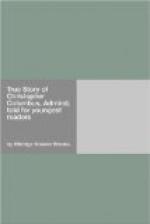As he sailed toward the coast a great canoe came close to the ship. It was almost as large as one of his own caravels, for it was over forty feet long and fully eight feet wide. It was paddled by twenty-five Indians, while in the middle, under an awning of palm-thatch sat the chief Indian, or cacique, as he was called. A curious kind of sail had been rigged to catch the breeze, and the canoe was loaded with fruits and Indian merchandise.
This canoe surprised Columbus very much. He had seen nothing just like it among the other Indians he had visited. The cacique and his people, too, were dressed in clothes and had sharp swords and spears. He thought of the great galleys of Venice and Genoa; he remembered the stories that had come to him of the people of Cathay; he believed that, at last, he had come to the right place. The shores ahead of him were, he was sure, the coasts of the Cathay he was hunting for, and these people in “the galley of the cacique” were much nearer the kind of people he was expecting to meet than were the poor naked Indians of Hayti and Cuba.
In a certain way he was right. These people in the big canoe were, probably, some of the trading Indians of Yucatan, and beyond them, in what we know to-day as Mexico, was a race of Indians, known as Aztecs, who were what is called half-civilized; for they had cities and temples and stone houses and almost as much gold and treasure as Columbus hoped to find in his fairyland of Cathay. But Columbus was not to find Mexico. Another daring and cruel Spanish captain, named Cortez, discovered the land, conquered it for Spain, stripped it of its gold and treasure, and killed or enslaved its brave and intelligent people.
After meeting this canoe, Columbus steered for the distant shore. He coasted up and down looking for a good harbor, and on the seventeenth of August, 1502, he landed as has been told you, near what is now the town of Truxillo, in Honduras. There, setting up the banner of Castile, he took possession of the country in the name of the king and queen of Spain.
For the first time in his life Columbus stood on the real soil of the New World. All the islands he had before discovered and colonized were but outlying pieces of America. Now he was really upon the American Continent.
But he did not know it. To him it was but a part of Asia. And as the main purpose of this fourth voyage was to find a way to sail straight to India—which he supposed lay somewhere to the south—he set off on his search. The Indians told him of “a narrow place” that he could find by sailing farther south, and of a “great water.” beyond it. This “narrow place” was the Isthmus of Panama, and the “great water” beyond it was, of course, the Pacific Ocean. But Columbus thought that by a “narrow place” they meant a strait instead of an isthmus. If he could but find that strait, he could sail through it into the great Bay of Bengal which, as you know and as he had heard, washes the eastern shore of India.




